
| What is Flavor and Fortune? |
| How do I subscribe? |
| How do I get past issues? |
| How do I advertise? |
| How do I contact the editor? |
Read 13110314 times
Connect me to:
| Home |
| Articles |
| Book reviews |
| Letters to the Editor |
| Newmans News and Notes |
| Recipes |
| Restaurant reviews |
| Article Index (all years, slow) |
| List of Article Years |
| Article Index (2026) |
| Article Index (last 2 years) |
| Things others say |
| Related Links |
| Log In... |
| Authors |
| Categories & Topics |
Mushrooms: Familiar and Less So--Part I
| by Jacqueline M. Newman |
Vegetables and Vegetarian Foods
Winter Volume: 2010 Issue: 17(4) page(s): 15, 16, 17, 18, 19, and 20
Mushrooms are familiar and consumed as both food and medicine in China. Less is known about them as food or as medicine in the rest of the world. Truth be told, most people know very little about these items also known as fungi. They know very few of them and while some consider them simply items of high nutritive value or contributors to a healthy diet, others revile them and believe them without calories, and with almost no value. If one were to generalize, most people know little to nothing about mushrooms.
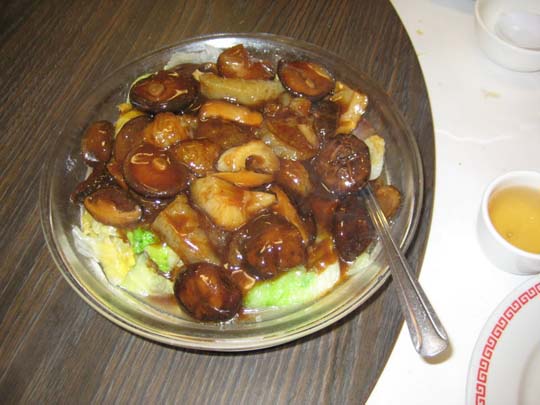 The Chinese, on the other hand, have known and written about mushrooms for thousands of years. They have also used them as medicine for that long or longer. They use many species, and they classified them long before anyone else ever thought to do so. In general, the words 'mushroom' and 'fungus' for one of them, and 'mushrooms' and 'fungi' for more than one are generally used interchangeably. That will be the case in this article and ones that follow in the next issues.
The Chinese, on the other hand, have known and written about mushrooms for thousands of years. They have also used them as medicine for that long or longer. They use many species, and they classified them long before anyone else ever thought to do so. In general, the words 'mushroom' and 'fungus' for one of them, and 'mushrooms' and 'fungi' for more than one are generally used interchangeably. That will be the case in this article and ones that follow in the next issues.
The earliest Chinese classification is in Tai shang Ling bao zhi Cao pin. It was written in the closing years of the Eastern Jin Dynasty (317 - 420 CE). More was detailed in the Dao Zang, a Daoist Canon. These writings about fungi and their correct botanical classifications, can be found in what are described as the 'world's first illustrated mushroom field guides.' Almost a thousand years, completed in 1245 CE and written by Chen Renyu, there was the first detailed Chinese monograph about mushrooms. It was called Jun Pu or the Guide to Fungi.
One of my favorite things about mushrooms is a Song Dynasty poem written by Yang Wanli (1127 - 1206CE). In it, he said that "after a rain, round mushrooms pop up from the steamy soil" and they are "as sweet as honey" and their "fragrance lingers between the teeth." Now these are early temptations to consume them; and I do!
This article is detailed to help readers because locating information about mushrooms is difficult. It is neither a history nor a review of what folks have written about them. It simply offers background and recipes for, in this issue, eight popular mushrooms found or cultivated in China. There will be others in Parts II and III in the next issues.
Why so many and so much information? Many have queried this magazine about various mushrooms and hopefully these back-to-back articles will provide the desired information they seek. For those who want or need to know more, when in Taiwan, go to the sixth floor of a local farmers association and visit the Taiwan Mushroom Museum. Founded in 1998 in Taichung County’s Wufeng Rural Township, it is well worth the visit to learn about them, even learn to love them. There, one learns that human use of mushrooms can be traced to the fifth millennium BCE, and that more than five thousand different mushrooms exist in Taiwan alone. This museum is one of about a handful worldwide dedicated just to fungi, and if you know of others, do tell us about them.
Fungi come in all colors, and we recall seeing many of them when visiting a grower in Singapore some years ago. There, we were amazed that he was raising pink and blue ones, orange ones, purple ones, and dozens of other colored mushrooms. Until that moment, thought these fungi were white to black and all shades of brown and tan.
Technically, neither fruit nor vegetable, many have sung the praises of these fast growing fungi, some of them grow overnight, almost all grow without chlorophyll, and most also grow in dark moist places. Much is now written about their fruiting bodies that is both fact and fiction. Some say they contain one hundred or more different antibiotics, help reduce everything from cholesterol to cancer, are loaded with oodles of bio-active polysaccharides, and that there are many medicinal reasons to devour them. However, do not devour every kind of mushroom that you see. Why not, because there are many known to be lethal. So do not go pick a single mushroom without a known trained mycologist with you. And, do only purchase yours from reliable sources. As the expression goes, it is better to be safe than sorry.
Chinese people have eaten mushrooms for many centuries and for many reasons. One of the main ones is that they believe there are some that enhance longevity. Another reason can be that seventy percent of all mushrooms worldwide are said to be found in China and the rest of Asia. In the wild, there and everywhere, they appear in great profusion after a rain; and currently, many of them are cultivated so one does not need to go foraging for them.
Au natural or cultivated, there are three types of mushrooms. One is called a parasite, and its type invades a living plant and feeds off its nutrients. Another type is known as a saprophyte, and it invades dead plants and extracts their nutrients. The third type is called symbiant; and they invade the roots of plants and with them extract nutrients from the soil.
Why people adore eating fungi is an interesting and important question. Some reasons, beside their fantastic taste enhanced by lots of glutamates, is that they are loaded with taste enhancers. Another is that have little if any fat, are low in calories, and have little if any sodium. Mushrooms also have several B vitamins, selenium and other minerals, and they have many components that are said to fight disease.
Selenium in mushrooms and any food, for men at least, is something that lowers the risk of prostate cancer. For men and women this mineral also has a role in keeping a heart healthy. Some mushrooms have a lot of potassium, as much as a medium-size banana, and this mineral has a positive impact on heart health. Most fungi have a lot of riboflavin for healthy skin, considerable niacin for digestive functions, and a good amount of pantothenic acid involved in the production of hormones and nervous system regulation. These other components are useful in the prevention of serious diseases and that is why one should eat them. The non-poisonous ones really are deemed healthy foods.
In the past forty years, a lot of research has been done on many kinds of mushrooms looking at how and why they reduce cancers, lower the risk of coronary heart disease, and boost the immune system. Asian and Western researchers found that button mushrooms may have a role in the prevention and treatment of breast and other cancers, HIV, and other disease states. For more about western research whose results are published in English, contact places such as the Beckman Research Institute in the City of Hope in California, the University of California at Davis, New York Medical College, and other places.
In the culinary realm, mushrooms go well with virtually all foods, some take on their flavors, others donate their own, and some go it both ways. In general, the flavors of all mushrooms intensify during drying and cooking. There are some that hold their crispness, others that give off lots of moisture, and still others that do other things.
Storing fresh mushrooms is best done in the refrigerator, in a single layer. Do so covering them with one or two lightly moistened paper towels, because self-defrosting refrigerators can dry them out; the paper towels need to be re-moistened daily. Storing dry mushrooms is very different. These need to be put in a tightly-covered jar with five to ten dry bay leaves. The aroma of these leaves prevents the spores and any tiny bugs that arrived with them from developing and/or hatching.
What follows are different varieties, their names in Chinese, some of their common names, botanical names, even some common foreign names, and some information about them. At the end of this and the remaining parts of the each article are one recipe for each of them, in the same order as their information. At the very end of all parts of these articles are recipes for using more than one mushroom in a single recipe.
There is much misinformation and overlapping information about mushrooms. These article may help sort them out. Seeing them and tasting them will add to knowledge gained. In many of the recipes, be aware that one can substitute one mushroom for another, though tastes will change. Our guess is that the pleasure of eating them will not. And now for the mushrooms, one by one.
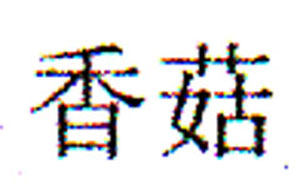
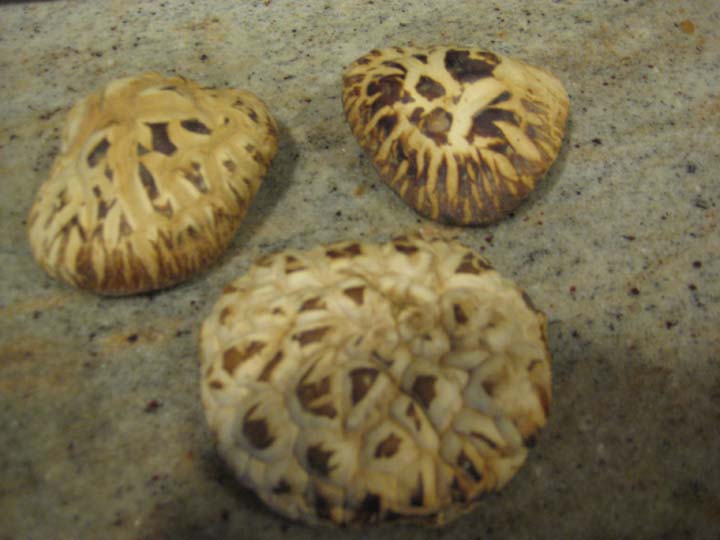 BLACK MUSHROOMS, also known as Chinese black mushrooms, black forest mushrooms, and by their Japanese name of shiitake are botanically known as Lentinula edodes, and also called fragrant mushrooms and flower mushrooms. The latter name is because the best of them have caps with deep crevices that take on a flower-like look. Also, for the former, they smell heavenly when cooking.
BLACK MUSHROOMS, also known as Chinese black mushrooms, black forest mushrooms, and by their Japanese name of shiitake are botanically known as Lentinula edodes, and also called fragrant mushrooms and flower mushrooms. The latter name is because the best of them have caps with deep crevices that take on a flower-like look. Also, for the former, they smell heavenly when cooking.
These black mushrooms, when cooked, have been used by the Chinese and all over Asia for centuries. In Chinese, they are called xiang gu, dong gu, and/or fa gu. They are loved because they enhance qi, and are said to exhibit strong immune activity. The Chinese believe these xiang gu have restorative powers; other cultures do, too. Japan''s FDA equivalent approves their use for immune activity needs, and traditional Chinese medical practitioners use them to treat heart disease, regulate liver functions, relax upset stomachs, enhance circulation, and more. Their extract has been used to inhibit dental caries, and act as an anti-fungal agent.
Dried and powdered, these mushrooms are added to teas, even consumed alone as a soup. Re-hydrated with their stems discarded, left whole or cut up, they are used in soups, stews, stir-fries, and dozens of different dishes. When soaking them, do not discard the liquid; save it to add to a soup, stew, or sauce; you will be glad you did. The general recommendation is to soak dried ones for twenty or more minutes until soft, and then to squeeze out any liquid and use that for cooking purposes, and use the mushrooms as desired after cutting off and dicarding their tough dried stems.
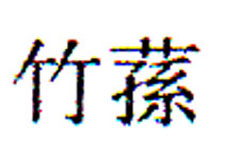
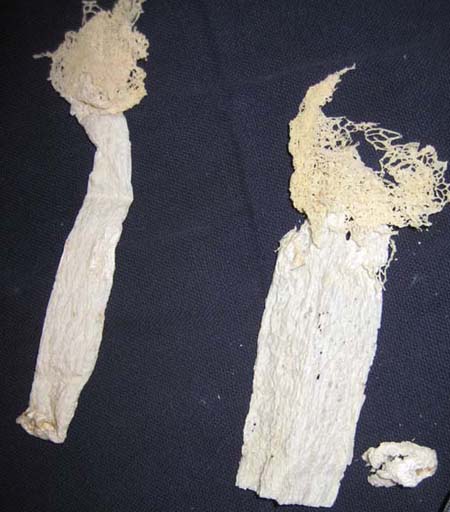 BAMBOO PITH MUSHROOMS are also known as bamboo mushrooms, velvet lady, long net stinkhorn, and basket stinkhorn mushrooms. The Chinese call them zhu sun and some refer to them as zhu sheng. Botanically, they are known most often as Dictyophora indusiata, and in the past have been known as Phallus indusiata. Commonly found in Yunnan, also in the Guangdong province, since the early 1980s these mushrooms are now cultivated, and most commonly, have now been canned (see picture taken from a can of them. They are loved by the Chinese, and are less well known by other cultures. However, they are also found wild in Japan, Mexico, and in South America.
BAMBOO PITH MUSHROOMS are also known as bamboo mushrooms, velvet lady, long net stinkhorn, and basket stinkhorn mushrooms. The Chinese call them zhu sun and some refer to them as zhu sheng. Botanically, they are known most often as Dictyophora indusiata, and in the past have been known as Phallus indusiata. Commonly found in Yunnan, also in the Guangdong province, since the early 1980s these mushrooms are now cultivated, and most commonly, have now been canned (see picture taken from a can of them. They are loved by the Chinese, and are less well known by other cultures. However, they are also found wild in Japan, Mexico, and in South America.
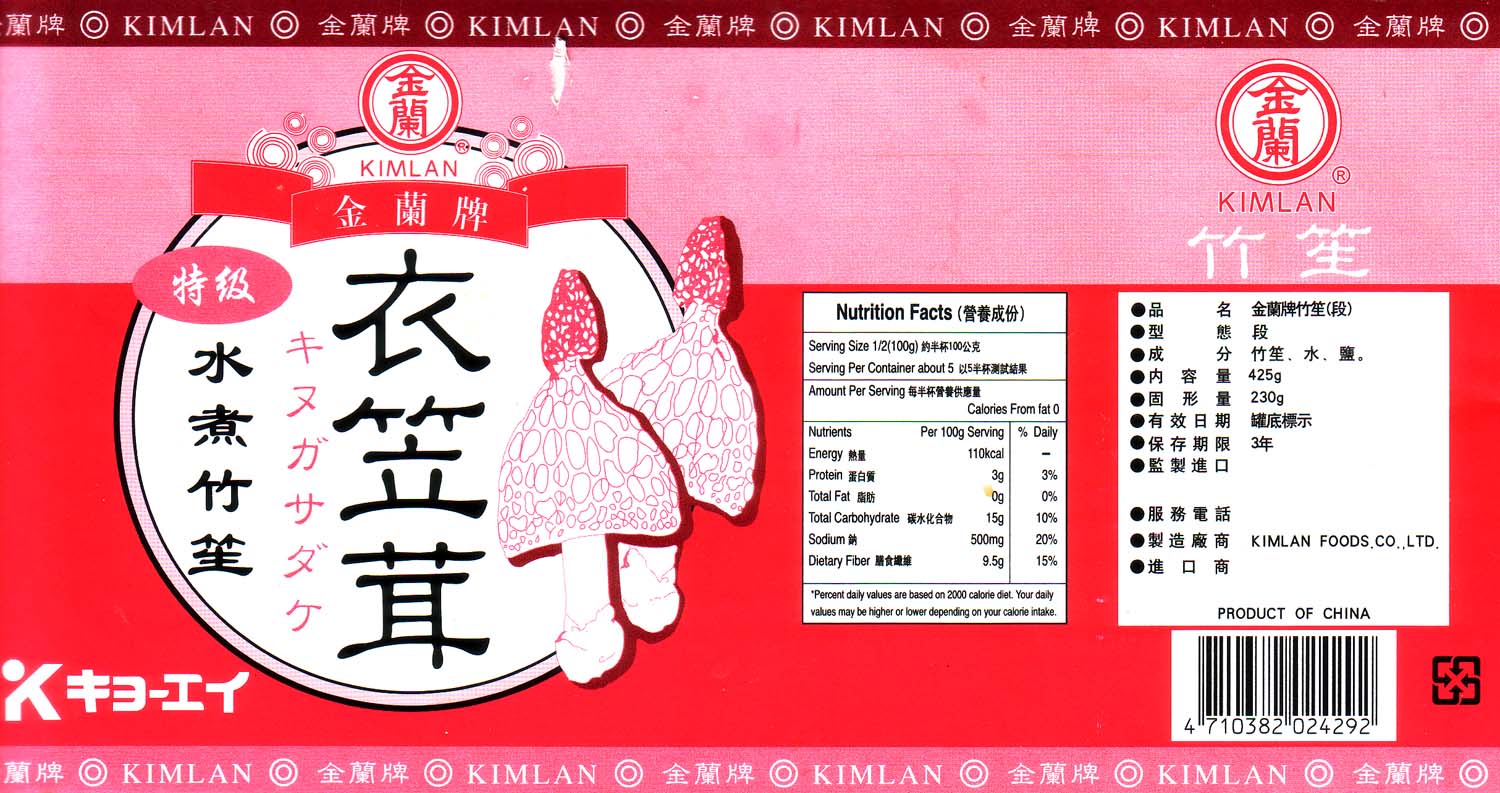 Bamboo pith is a beautiful mushroom with a white veil that can grow to full size in as little as eight hours. It does drop its veil after that part is fully grown and that might be in only one hour. In most countries these fungi are sold in Chinese and other Asian markets in the dried form in various bundled amounts. Look for them held together with white or colored string.
Bamboo pith is a beautiful mushroom with a white veil that can grow to full size in as little as eight hours. It does drop its veil after that part is fully grown and that might be in only one hour. In most countries these fungi are sold in Chinese and other Asian markets in the dried form in various bundled amounts. Look for them held together with white or colored string.
Best purchased when white or very light, most chefs recommend soaking them for but a few minutes; and many of them cut off the rounded top and reserve this part for a soup or stew. They are liked stuffed, and to do that, it is easiest to cut them open and wrap them around a filling. Actually, that is easier than stuffing them because they tear easily. To do, cut the lacy part down one side, put the stuffing in the center of it, then roll it up the long way, and sit it cut side down when cooking. After cooking, the stuffing tends to hold everything together.
This mushroom was discussed in an article in Flavor and Fortune's Volume 6(4) on pages 25 and 30. It included a recipe called Bamboo Pith with Bean Curd. A few other recipes can be found in the recipe index, and there will be another at the end of the article. For others, consult newer Chinese cookbooks, ask someone at your local Chinese restaurant, use the web, and continue to subscribe for others.
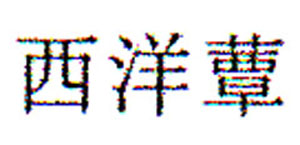
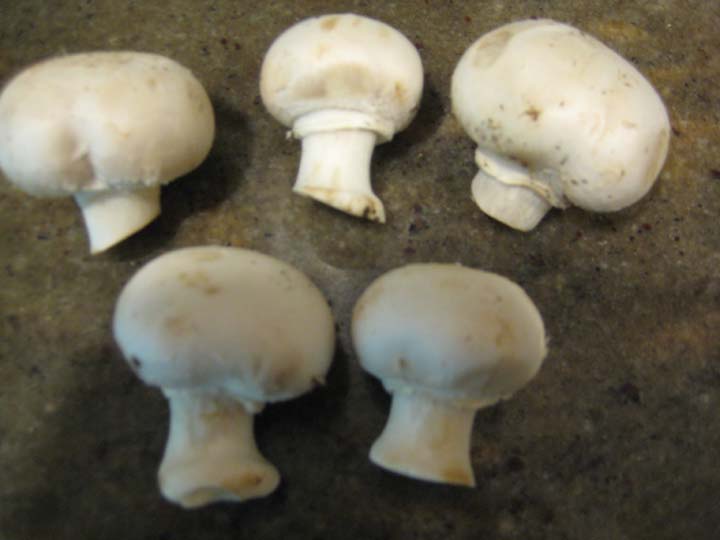 BUTTON MUSHROOMS, also known as champignon or white button mushrooms, are the most commonly consumed mushroom in the United States. They have a short thick stem in the center of the cap, and when very young, the gills underneath are pinkish, darkening as they age. Botanically known as Agaricus bisporus, in Chinese, the general term for mushrooms is mo gu. In the 1970''s, the button or common mushroom, as many books call it, was the most exported mushroom in Taiwan. That title now goes to the golden enoki mushroom.
BUTTON MUSHROOMS, also known as champignon or white button mushrooms, are the most commonly consumed mushroom in the United States. They have a short thick stem in the center of the cap, and when very young, the gills underneath are pinkish, darkening as they age. Botanically known as Agaricus bisporus, in Chinese, the general term for mushrooms is mo gu. In the 1970''s, the button or common mushroom, as many books call it, was the most exported mushroom in Taiwan. That title now goes to the golden enoki mushroom.
Button mushrooms can be eaten raw, marinated, or cooked. When they get wet, they become soft and mushy in short order, so little cooking or stir-frying is recommended to maintain their texture, but do cook them until they bleed most of their moisture. These mushrooms can grow in less than clean areas, so it is important to use a soft brush to clean away dirt on the cap, also any soil or other debris on or around the stem. For storing them, put them in a dry paper bag with a dry paper towel inside.
These mushrooms have the enzyme tyrosinase, a medicine used to make a drug that reduces blood pressure. Some say these fungi help that, and they reduce tumors, especially those in the breast. The Chinese have recently suggested that women increase their consumption.
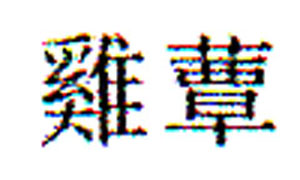
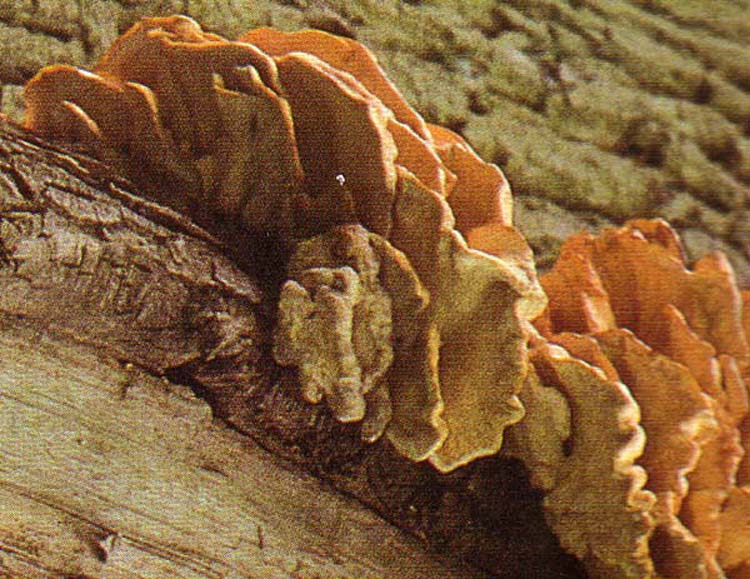 CHICKEN OF THE WOODS MUSHROOMS, botanically known as Laetiporus sulphureus or Polyporus sulphureus are also known as Laetiporus conifericpola. This latter name may be because they grow on soft woods, conifers included. Though there are three botanical names, the very first one is the one most commonly used. This fungus is bracketed and spectacular as its color is often bright yellow when young. That is why it is also known as sulphur shelf mushroom.
CHICKEN OF THE WOODS MUSHROOMS, botanically known as Laetiporus sulphureus or Polyporus sulphureus are also known as Laetiporus conifericpola. This latter name may be because they grow on soft woods, conifers included. Though there are three botanical names, the very first one is the one most commonly used. This fungus is bracketed and spectacular as its color is often bright yellow when young. That is why it is also known as sulphur shelf mushroom.
Extensively cultivated in all of Asia, and most popular in China, these mushrooms are loved when fresh and young. Many grow in a fan-shape or in overlapping curves; they are white or tan on the interior, and their exterior darkens with age and as such, the mushroom gets tougher. Often found growing on deciduous trees, these mushrooms can be used when fresh and they can be frozen after cooking. As they age, they do get bitter, and if they do, chefs recommend blanching them in boiling salted water for two or three minutes to reduce the bitterness.
This family of mushrooms does not dry well, so use them soon after harvesting. Keep in mind that once a dish is cooked with them, that dish will then freeze well. Vegetarians adore these fungi as they taste somewhat like chicken and their texture looks like and feels like poultry.
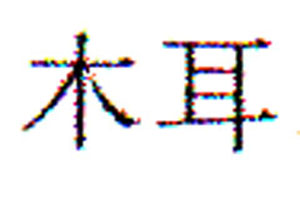
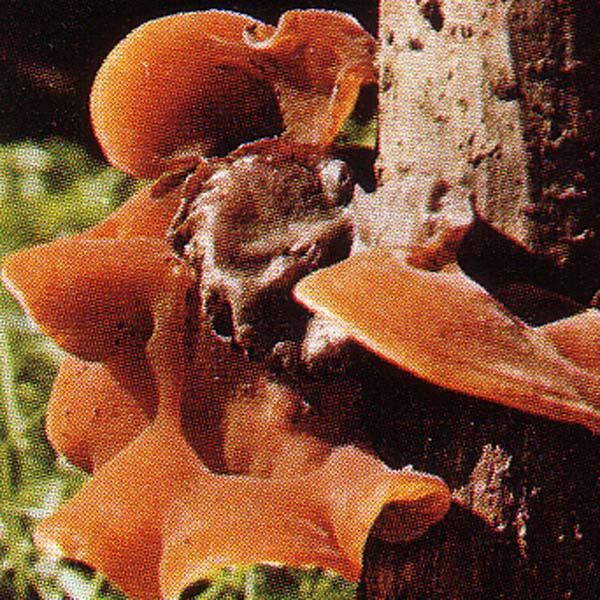 CLOUD EAR MUSHROOMS, also known as wood ear, jews ear, and tree ear, botanically these fungi are known as Auricularia auricula judae. Called mu er or mo-er, they are rubbery and lobed; and best known for their use paired with tiger lily buds in Hot and Sour Soup. They are also used in many other dishes.
These fungi grow out of dead deciduous trees and their branches, especially those of elder trees, and they grow on other hard woods within a living tree. When fresh, though rarely found that way in markets, they are honey colored to brown. When dried, they are black, at least on one side, and sometimes the other is lighter and gray.
CLOUD EAR MUSHROOMS, also known as wood ear, jews ear, and tree ear, botanically these fungi are known as Auricularia auricula judae. Called mu er or mo-er, they are rubbery and lobed; and best known for their use paired with tiger lily buds in Hot and Sour Soup. They are also used in many other dishes.
These fungi grow out of dead deciduous trees and their branches, especially those of elder trees, and they grow on other hard woods within a living tree. When fresh, though rarely found that way in markets, they are honey colored to brown. When dried, they are black, at least on one side, and sometimes the other is lighter and gray.
Culinary sources throughout Asia use these popular fungi. Younger smaller ones can be called tree ears and older, larger, thicker ones called wood ears. While there is no distinct determined differences in these nomenclatures, these differences can be featured in markets.
Medical personnel do suggest eating some to reduce cholesterol, and many are doing just that, others taking them to reduce blood pressure. They are a very inexpensive way to reduce these growing problems as people are living longer and longer.
These mushrooms, when foraging for them, like most others are more commonly found when cool weather begins, but they can and do grow year round, not just in the fall. They are considered best when dried and reconstituted by soaking in warm water for twenty or so minutes until soft. Also considered important, is to cut away and discard firm or lumpy parts that do not soften after soaking, and to rinse them afterwords before using them to rid them of any sand or other debris.

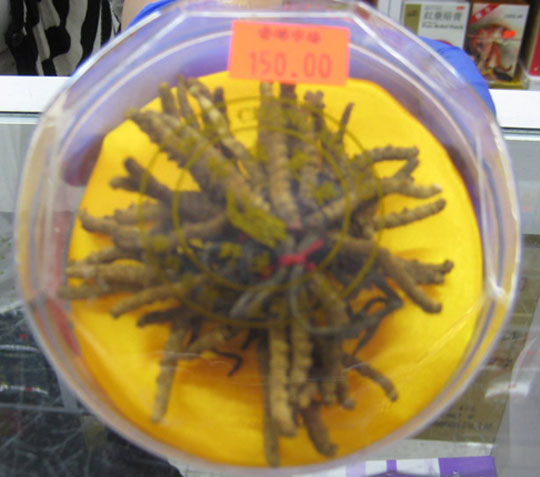 CORDYCEPS MUSHROOMS, also known as 'winter worm-summer grass' and as 'caterpillar fungus,' are botanically known called Cordyseps sinensis. The Chinese call these long skinny fungi dong chong xia cao. They grow on dead worms or insects, and for centuries, the Chinese have touted them for general malaise, increased stamina, endurance, and for improving a person''s sexual capacities.
CORDYCEPS MUSHROOMS, also known as 'winter worm-summer grass' and as 'caterpillar fungus,' are botanically known called Cordyseps sinensis. The Chinese call these long skinny fungi dong chong xia cao. They grow on dead worms or insects, and for centuries, the Chinese have touted them for general malaise, increased stamina, endurance, and for improving a person''s sexual capacities.
Years ago, these revered items were reserved for royalty. Then and now they have a common street name, that of being the 'elixir of life.' They have been used by the Chinese at several athletic events including in 1993 when their female athletes at the World Track and Field Meet in Germany consumed them and then broke nine world records.
Once regarded as one of the most expensive of herbs, the Chinese care not and spend whatever they cost using them for anti-aging, supporting weak hearts, decreasing cholesterol, reducing stomach ulcers, increasing insulin secretion, and to support a healthy sexual drive.
Cooking cordyceps is popular, among those that can afford to purchase them, as one of them can cost five to ten dollars. Used whole or cut up in stuffings, particularly when roasting duck or goose, in soups and stews, and in beverages, particularly alcoholic drinks, most often they are used whole to show they are real and really there. They can also be purchased as a powder, and in that form are popular in tea with or without other herbs.
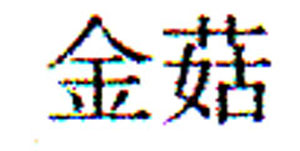
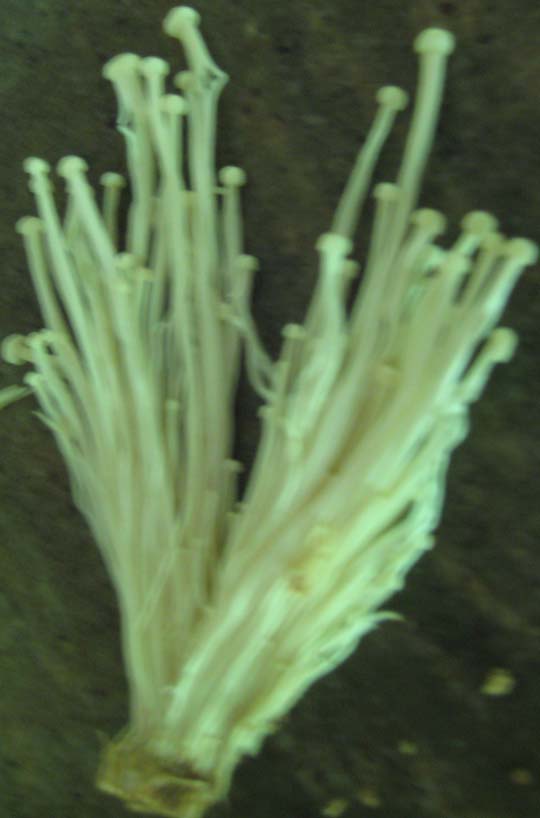 GOLDEN WINTER MUSHROOMS, like many other fungi, these mushrooms have many names. They are known as golden mushrooms, velvet shark mushrooms, and show mushrooms. The Japanese call them enoki or nameake mushrooms. Enoki is taking hold as their name in the United States. Botanically called Flammulina velutipes, these mushrooms were formerly known as the Collybia velutipes mushrooms. No matter their name, they usually grow on stumps of the Chinese hackleberry tree (whose name in Japanese is the enoki tree).
GOLDEN WINTER MUSHROOMS, like many other fungi, these mushrooms have many names. They are known as golden mushrooms, velvet shark mushrooms, and show mushrooms. The Japanese call them enoki or nameake mushrooms. Enoki is taking hold as their name in the United States. Botanically called Flammulina velutipes, these mushrooms were formerly known as the Collybia velutipes mushrooms. No matter their name, they usually grow on stumps of the Chinese hackleberry tree (whose name in Japanese is the enoki tree).
Known since the Yuan Dynasty, they grew wild then, and still grow wild in the north of China. They came to Taiwan and were cultivated in 1970; they are now a major economic resource there, one of the most exported of mushrooms.
To cook with these mushrooms requires restraint. First, cut off their roots, then put them in a hot dish at the very last moment. Rarely are the stems cut; the Chinese and the Japanese like the look of them long and thin; and they like the texture quite crisp. Before using them in cold or hot dishes, it is recommended they be rinsed in cold water, and dried on paper towels.
Should one go foraging for these long skinny mushrooms, do not look for them as purchased in a market. Those found in the wild will have shorter stems and a fatter caps. As to dishes to cook them in, the Chinese love their taste and texture, and mostly use them to look pretty as a garnish, or in contrast to darker-colored foods.
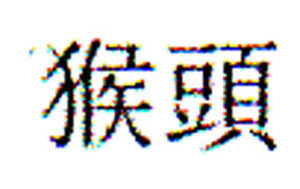
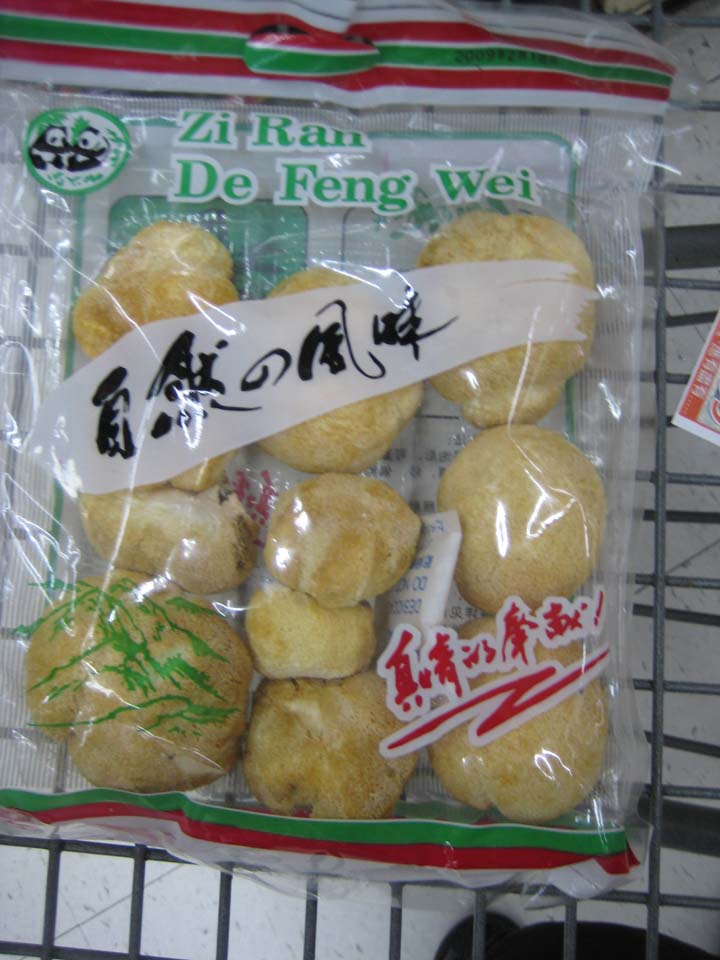
LION’S MANE MUSHROOMS, monkey head, or Herciium erinaceus, these are considered precious rare Chinese mushrooms. Now and most recently cultivated, thay are showing up in in many Asian markets. These fungi were and still are believed to be brain tonics even though some call them hedgehog mushrooms, bear''s head mushrooms, old man''s beard, bearded tooth, sheep''s tooth mushroom, and most recently, the pom pom mushroom.
Grown in the Yunnan and Heilongjiang provinces, this mushroom is considered one of China's 'four delicacies;' the others are bear paw, bird's nest, and shark's fin. Aside from their delicious and delicate taste, and their interesting ultra-thin protrusions over the entire head, Chinese medical personnel believe they stimulate nerve growth in the head–meaning the brain, and so they now use them for Alzheimer patients and others with neurologic brain diseases.
These fungi, now available fresh in many countries, the United States included, are considered of value for the elderly, good for digestive maintenance, to increase immunity, reduce blood pressure, help those with ulcers, keep high blood pressure in check, and be of value for those with chronic atrophic gastritis.
Fresh ones are usually cut into any desired shape, dried ones reconstituted by soaking in tepid water until soft, then cut as desired, often to match the shape of the other ingredients in a dish. The Chinese like them with fresh ginger, seafood, and fresh herbs; and made in many ways.
These mushrooms when fresh, turn dark tan from ultra-white; and they shrivel soon after cutting from a stump or dead tree where they are usually found. This change can happen in half a day after cutting and packing them. This mushroom was written about in Flavor and Fortune's Volume 8(2) on pages 20 and 21, so do red more about them there.
Part II of Mushrooms: Familiar and Less So will discusses addtional mushrooms and will have one recipes for each of them. Part III will have still other mushrooms and one recipe for each one in this part of the article, and a few recipes using more than one kind of mushroom in a single dish. Now for the recipes of mushrooms discussed above, in the same order as the individual mushrooms are presented.
| Stuffed Chinese Black Mushrooms |
|---|
6 ounces minced or ground pork 6 water chestnuts, minced 1/2 teaspoon granulated sugar 1/2 teaspoon Chinese rice wine 2 slices peeled fresh ginger, minced 1 teaspoon dark soy sauce 2 Tablespoons oyster sauce 1 Tablespoon cornstarch or tapioca starch 20 large Chinese black mushrooms, soaked, their stems removed and discarded, the mushroom water set aside 20 leaves of fresh coriander 1 teaspoon vegetable oil Preparation: 1. Mix pork, with the minced water chestnuts, sugar, rice wine, and the fresh minced ginger, and the soy and oyster sauces. 2. Dust the underside of the mushrooms with the selected starch, and wet hands and put some of the pork mixture onto each mushroom cap, dusting any remaining starch on top of the meat mixture. Put a coriander leaf on top of each mushroom. 3. Heat wok, add the oil, and put the mushrooms filling side up into the wok, and lightly brown them. Then add half cup of the mushroom water, if not enough, add in broth or plain water, cover the wok and simmer for fifteen to twenty minutes, until the pork mixture is throughly cooked. 4. Remove the cover, put the mushrooms on a pre-heated platter, pour any juices over them, and serve. |
| Bamboo Pith Mushroom Dumplings |
|---|
2 cups flour 1/2 cup fresh lily bulb pieces, minced 1/2 cup water chestnuts, minced 1/4 cup hollow stem vegetable, coarsely minced 1/4 cup soaked bamboo pith mushrooms 6 Chinese black mushrooms, soaked, stems discarded, and minced 1 teaspoon salt 2 teaspoons granulated sugar 1 egg white 1 teaspoon vegetable oil Preparation: 1. Mix flour with one cup boiling water, stir well, and allow to rest covered for ten minutes. Knead into a soft dough, divide into twenty pieces, and roll each one out, cover with a cloth, and set aside until needed. 2. To make the filling, mix lily bulb, water chestnut, vegetable, and both kinds of mushroom pieces, then add egg white, salt, and sugar, and stir well. 3. Wet one piece of the dough on the edges, fill with two teaspoons of the filling and pinch the dumpling closed. Then set it on a dry plate and continue until all are made. 4. Put a piece of parchment paper on the steamer rack, put all the dumplings on it being sure they have half inch of space between them, and steam over rapidly boiling water for five minutes, remove to a lightly oiled platter, and serve. |
| Button Mushroom Fans |
|---|
1 pound button mushrooms cleaned, but not washed, each one with their stems removed 2 cups vegetable oil 1 teaspoon soy sauce 1 Tablespoon minced Sichuan cabbage 1 teaspoon sugar and salt, mixed 1 teaspoon Chinese rice wine 1/2 teaspoon sesame oil Preparation: 1. Slice each mushroom into fans, but do not cut any slice all the way from one end to the other, leave one-quarter inch uncut. 2. Heat oil and deep-fry the mushrooms, they will fan out, when golden brown. Drain on pare towels and set these aside on a pre-heated platter. 3. In a very small pot, heat soy sauce, the minced Sichuan cabbage, salt and sugar, and the rice wine and sesame oil until hot but not boiling. Pour this over the mushrooms, and serve. |
| Bean Curd and Chicken of the Woods Mushrooms |
|---|
1/4 pound fresh chicken of the woods mushrooms, blanched for two minutes, then drained and coarsely chopped 1 square firm bean curd, sliced horizontally into four pieces 3 Tablespoons vegetable oil 1/2 carrot, peeled and minced 2 Chinese black mushroom, soaked, stem discarded, and minced 2 Tablespoons vegetarian oyster sauce 1 teaspoon sugar dash ground white pepper 1 Tablespoon cornstarch mixed with two tablespoons of cold water Preparation: 1. Heat wok or fry pan, add one tablespoon of the oil, and fry the chicken of the woods mushrooms for one minute, remove and set aside. 2. Add the rest of the oil and fry the bean curd slices until crisp first on one side, then on the other. Remove them first to paper towels, then to a pre-heated platter. Put the chicken of the woods mushrooms o top of the bean curd slices. 3. Put carrot and black mushroom pieces in the wok with any remaining oil, and stir-fry for two minutes. Then add oyster sauce, sugar, ground white pepper, and the cornstarch mixture, and stir until thickened. 4. Pour the carrot-mushroom mixture over the bean curd and the chicken of the woods mushrooms, and serve. |
| Hot and Sour Chicken Soup |
|---|
1 boneless chicken thigh 3 chicken wings, bones removes, each wing turned inside out 3 Tablespoons cloud ear fungus, soaked for twenty minutes in warm water 1 Tablespoon vegetable oil 1 small chili pepper 3 slices peeled fresh ginger 1 scallion, cut into one-half inch pieces 1 Tablespoon Shao Xing wine 1 Tablespoon thin soy sauce 1 Tablespoon mushroom soy sauce 1 Tablespoon Chinese black vinegar 2 Tablespoon cornstarch mixed with one tablespoon cold water 6 cups chicken broth Preparation: 1. Cut chicken thighs and inside out wings into one-inch pieces. 2. Remove any debris or thick parts from the fungi, and cut them into one-inch pieces. 3. Heat oil and fry the chili pepper and the ginger for two minutes, then discard them and put the chicken pieces into the oil, and stir-fry for two minutes before adding the scallion pieces, wine, sioy sauce, and vinegar. Stir well, the add cornstarch mixture and the broth and bring to the boil stirring all the time, then put into a soup tureen or ladle into individual soup bowls. |
| Yin Yang Health Soup |
|---|
1 pound pork shin meat, cut into one-inch cubes 2 Tablespoons minced ginseng root 5 caterpillar/cordyceps fungi, scalded in boiling water 5 Chinese black dates, each cut into four pieces 10 canned lotus seeds 3 slices fresh ginger, cut into thin shoestring pieces 1/4 teaspoon salt Preparation: 1. Put cubes of pork shin into boiling water and scald them there for two minutes. Rinse them in boiling water and put into a large clean pot. 2. Add two cups of boiling water to the clean pot, and add the ginseng, dates, lotus seeds, ginger, and salt and simmer for ninety minutes, Taste, and add additional salt, if needed, then serve. |
| Fried Golden Winter Mushrooms |
|---|
1 cup golden winter mushrooms 3 Tablespoons silver ear fungi 2 Tablespoons vegetable oil 1/2 cup canned pineapple pieces, cubed 1 gherkin, minced 1 teaspoon salt 1 Tablespoon sugar 2 Tablespoons cornstarch mixed with one-quarter of a cup of cold water Preparation: 1. Soak golden winter mushrooms in cold water for ten minutes, then rinse and drain and cut into half-inch slices. 2. Soak silver ear fungi for ten minutes, then put into two cups cold water, bring to the boil, and simmer for half an hour, then drain and discard the water. Tear these fungi into half-inch pieces. 3. Heat wok or fry pan, add the oil, and fry both kinds of fungi together for two minutes before adding the pineapple and gherkin pieces. Fry for another minute. 4. Mix salt, sugar, and the cornstarch water, stir into the wok or fry pan and keep stirring until thickened, then serve. |
| Monkey Head Mushrooms, Crispy and Spicy |
|---|
6 to 8 dried monkey head mushrooms, soaked for one hour in tepid water 1 Tablespoon ginger juice 3 Tablespoons Chinese yellow rice wine 1 egg white salt and sugar, to taste 3 Tablespoons lotus root flour 1 cup vegetable oil 2 cloves fresh garlic, peeled and sliced 1 Tablespoon fermented black beans, rinsed then chopped 3 small hot pickled chili peppers a few lettuce leaves put on a platter Preparation: 1. Gently squeeze water out of the monkey head mushrooms, then slice them thinly. 2. Soak these mushroom slices in the ginger juice, rice wine, and the egg white, and the salt and sugar for half an hour, stirring two or three times during this time. 3. Coat the mushrooms with the lotus root flour, stirring them gently. 4. Heat a wok or a fry pan, add the oil, and fry the mushrooms until they are crisp, then remove them from the oil and drain on paper towels. 5. Into the oil still in the wok, fry the garlic, black beans, and the chili peppers, and when all is really hot, add the mushrooms, and stir gently for one minute, then remove from the oil, put the lettuce leaves on a platter, and the mushroom mixture on top, and serve. |

Copyright © 1994-2026 by ISACC, all rights reserved
Address
3 Jefferson Ferry Drive
S. Setauket NY 11720